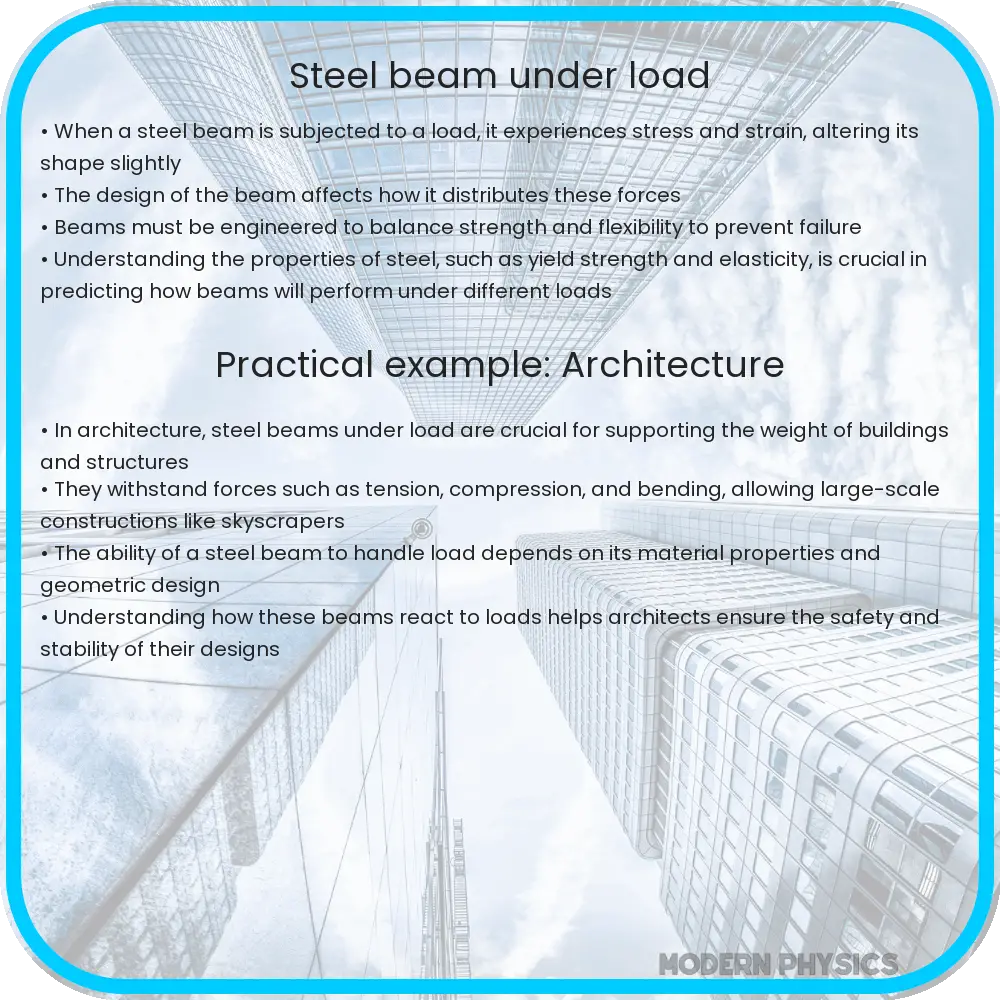Explore the strength, flexibility, and design of steel beams under load in modern construction, highlighting trends in material science and sustainability.

Understanding the Mechanics of Steel Beams Under Load
Steel beams are a fundamental component in modern construction, known for their strength, flexibility, and versatility in design. Their ability to bear loads and maintain structural integrity is crucial in engineering and architectural applications. This article delves into the core aspects of steel beams under load, focusing on their strength, flexibility, and design considerations.
Strength of Steel Beams
The strength of a steel beam is primarily determined by its material properties and cross-sectional shape. Steel, an alloy primarily made of iron and carbon, exhibits high tensile and compressive strength. The addition of other elements like manganese, phosphorus, sulfur, and silicon can enhance these properties. The strength of steel is often measured in terms of yield strength, which is the stress at which a material begins to deform plastically. For standard structural steel, the yield strength typically ranges from 250 to 400 MPa (mega pascals).
Furthermore, the design of a steel beam significantly influences its load-bearing capacity. The most common shapes are the I-beam and H-beam, which provide an optimal balance between weight and strength. The geometry of the beam, including its height, width, and thickness, plays a pivotal role in its ability to withstand loads.
Flexibility and Deformation
Flexibility, or ductility, is another critical characteristic of steel beams. It refers to the ability of the material to deform under stress without breaking. This property is essential for absorbing energy during events like earthquakes and wind loads, making steel an ideal choice for seismic zones. The modulus of elasticity (E), typically around 200 GPa (gigapascals) for structural steel, is a measure of a material’s stiffness and is used in calculating deflection under load.
Deformation in steel beams is often analyzed using the formula δ = (FL3)/(48EI), where δ is the deflection, F is the applied force, L is the length of the beam, E is the modulus of elasticity, and I is the moment of inertia. This formula helps engineers predict how a beam will behave under specific load conditions.
Design Considerations
When designing with steel beams, engineers must consider factors like load type (static or dynamic), load distribution (uniform or point load), and environmental conditions. The design must ensure that the beam can safely carry the expected loads without excessive deflection or failure. Additionally, considerations for fire resistance and corrosion protection are essential for ensuring the longevity and safety of the structure.
Advancements in steel manufacturing have led to the development of high-strength steels and innovative beam shapes, further expanding the possibilities in structural design. These developments allow for more significant spans and slenderer structures, pushing the boundaries of modern architecture.
In conclusion, the strength and flexibility of steel beams under load are pivotal in their widespread use in construction. Understanding these properties and their implications on design is fundamental for engineers and architects in creating safe, durable, and aesthetically pleasing structures.
Advanced Applications and Future Trends
With the evolution of engineering and material science, steel beams are being tailored for more advanced applications. One such development is the use of high-strength, low-alloy (HSLA) steels. These steels offer enhanced strength-to-weight ratios, allowing for lighter structures without compromising on load-bearing capacity. This innovation is particularly beneficial in high-rise buildings and long-span bridges where weight reduction is crucial.
Another trend in the field is the integration of smart technologies. Smart steel beams, equipped with sensors, can monitor the health of a structure in real-time. These sensors detect changes in stress, temperature, and vibrations, providing valuable data for preventive maintenance and ensuring structural integrity over time.
Sustainability and Environmental Considerations
Sustainability is becoming an increasingly important factor in construction. Steel beams are advantageous in this regard due to their recyclability. Steel can be recycled indefinitely without losing its properties, making it a sustainable choice for environmentally conscious projects. Additionally, modern steel manufacturing techniques are focusing on reducing carbon emissions and energy consumption, further enhancing the environmental profile of steel as a construction material.
Environmental conditions also play a critical role in steel beam design. Corrosion resistance is a significant consideration, especially in harsh environments like coastal areas or industrial zones. Protective coatings and galvanization are commonly employed to extend the lifespan of steel beams in such conditions.
Conclusion
Steel beams, revered for their strength and flexibility, are indispensable in modern construction. The intersection of engineering principles, material science, and innovative design has allowed steel beams to evolve from mere structural elements to sophisticated components integral to the safety, functionality, and aesthetics of buildings and infrastructure. The ongoing advancements in steel technology, combined with a growing emphasis on sustainability and smart monitoring systems, are poised to further enhance the capabilities and applications of steel beams. As we move forward, steel beams will undoubtedly continue to play a pivotal role in shaping the skylines of our cities and the infrastructure that supports our societies.
Ultimately, the journey of understanding and utilizing steel beams under load is not just about appreciating a material’s properties. It’s about recognizing the synergy between material science and engineering innovation in creating structures that are not only safe and efficient but also sustainable and adaptable to future challenges.
